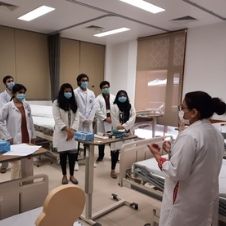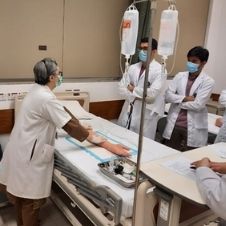Shifting Gears and Collaborative Teaching: Bench to Bed Module for Medical Students
This story is written by Zohra Asif Jetha, Senior Instructor, School of Nursing and Midwifery, Aga Khan University, Pakistan
A New Journey:
In many healthcare institutions, healthcare professionals cannot work solo without a team of experts. Nurses, doctors, and other allied health care professionals need to learn to work collaboratively so as to provide safe, quality care to clients in a holistic manner. (Morley & Cashell, 2017). As a nurse educator, I can relate to the quote by Florence Nightingale "Nursing is an art, and if it is to be made an art, it requires as exclusive a devotion, as hard a preparation, as any painter's or sculptor's work, for what is having to do with the living body." (cited in Donahue 1996:501). I believe that the scope of my teaching is not limited to the nursing students only; I have always been interested in teaching other medical education programs as well. Working in collaboration always helps us learn and train together.
I was super excited, nonetheless anxious, ready to switch my gears for a collaborative teaching assignment. I was asked to design a joint teaching module for Aga Khan University Undergraduate Medical Education (UGME) students, an introductory module on the "bench to bed."
Planning the Humongous Collaboration:
"Bench to Bed" was an eight-week introductory module for year III medical students, and I was the coordinator for planning the one-week Clinical Skills section.
After I was tasked with this assignment, I began to brainstorm about the plan, pulled out all my experiences and pedagogy tools that I learned from the Network of Quality Teaching and Learning (QTL_net), and use the best techniques to formulate objectives. Also, I approached my nursing colleagues to help me develop a comprehensive module plan, focusing on the learning objectives and aligning them with multimodal teaching. I sought feedback from my nursing colleagues. The five-day program had various activities, including online workshop hours, skills practice and sign-off hours, and observational clinical hours at the hospital site. The detail of the activities are as follows:
Online Workshop
On day one, UGME students attended a workshop via zoom. Knowledge experts conducted online sessions and discussed the scope of nursing, the significance of the multidisciplinary approach, infection control measures, and different online applications, such as SAHL and the online incident reporting system.
For the next four days, students had to go for skills practice and clinical observation experience. However, they were divided into small groups of 25 individuals considering the importance of following SOPs in the skills lab and ward areas due to the Covid-19 pandemic.
Skills at CIME

Four stations were set up in CIME for skills demonstrations and practice, and an expert nursing faculty facilitated each station. Furthermore, we divided the group of twenty-five students into subgroups of 8-9 people. The subgroups had to practice the basic skills, demonstrate, and receive a sign-off within one and a half hours. Thus, the day started with a pre-briefing and demonstration of a skill, followed by practice time, and ended with a debriefing session.
Observational Clinical Experience

An official memo was shared with the Nursing Education Services (NES) that comprised students' names, ID numbers, and clinical objectives for one week. In addition, we developed a duty roaster in which we divided the students into morning and evening shift duties. Two nursing faculty with nine teaching associates (TAs) were assigned to facilitate the medical students, conduct clinical rounds, and evaluate the students' learning and skill performance using a skills checklist.
Celebrating our Success
Overall, the module was completed on time while achieving all the pre-determined learning objectives. The support of the Aga Khan University School of Nursing and Midwifery (SONAM) leadership and faculty members and the other supporting staff was exemplary. The teaching associates were beneficial, and the assignments they assigned to the students to facilitate their learning were highly appreciated, as shown in the student evaluation.
At the end of the module, an evaluation was conducted. The students were given evaluation forms that consisted of seven questions that students had to attempt using the Likert scale where 1= Disagree, 2= Neutral, and 3= Agree. Hence, the average score received from students was 17.5 out of 2. Moreover, we asked them two open-ended questions to gather information about their recommendations for future collaborative modules and the challenges they faced during the module. Some students responded as follows:
"This module was truly filled with learning; it helped enhance the doctor-patient interaction, know the importance of nurses and the paramedical staff and how hospital setting works where people cooperate and learn together" (UGME std 1).
"It was a good module, I enjoyed and learned. CIME sessions were great. We got a lot to learn in that, and I think more such sessions can help us get hold of the skill" (UGME std 2)
"A decent pilot program that should continue. I learned so many new skills that I am excited to apply in clinics." (UGME std 3)
"It was interesting. Learnt things that I will remember as I further my medical education" (UGME std 4)
"Excellent initiative which I feel has oriented me to the basics of clinical setting" (UGME std 5)
Challenges Encountered:
As every new endeavor has teething problems and lessons from which we can learn, I also encountered difficulties within logistical arrangements and coordination among departments, such as venue arrangements and CIME booking. When we had assigned few students in emergency units, we failed to check their N95 fitness test prior. So, these students were not allowed to do their clinical observation and were relocated to a different placement. Numerous changes had to be made to the clinical roster for students to get equal learning opportunities and skill practice exposure. Teaching associates were assigned to students a bit later in the module, and it was not easy for only two teachers to shadow the students. Also, to make the communication more manageable, we developed a list of students with their cellphone numbers; However, I believe we should have done this before the clinical rotation started.
Way Forward:
Although it was a first-time brief collaborative teaching experience, it gave us an opportunity for reflection on how to strengthen further collaborative teaching and learning practices between nursing school and medical college. In the future, this idea can be integrated with nursing and medical students; This will provide opportunities for both Programmes to learn clinical and technical skills like communication, patient assessment, and responding to code alert simulation-based teaching. Studying and working together from the beginning will expose nursing and medical students to each other and reduce the communication gap when they graduate and work in health settings. They are expected to work as a team to improve patient outcomes once they graduate.
Acknowledgment:
Dr. Rubina Barolia, Zulekha Saleem, Shirin Rahim, Zahra Tharani, Farzana Yameen, Khairunnisa Mansoor, Salima shams, Parveen Chagani, Razia Momin, Shanaz Cassum Roomi Ali, Hina Saleem, and Teaching associates).
References
- Morley, L., & Cashell, A. (2017). Collaboration in health care. Journal of medical imaging and radiation sciences, 48(2), 207-216.
- Donahue, M. P. (2011). Nursing, the finest art: An illustrated history. Mosby. Yearbook; inc; USA.
- Centers of Disease Control and Prevention (CDC) (2019) Retrieved from,
- https://www.cdc.gov/coronavirus/2019-ncov/prevent-getting-sick/types-of-masks.html


